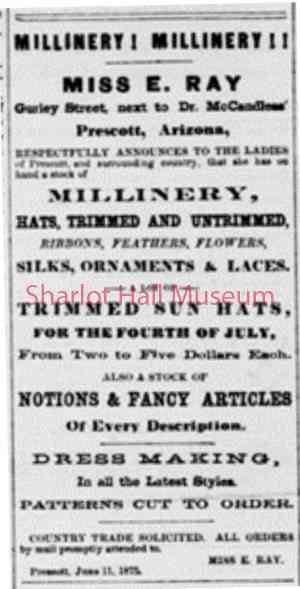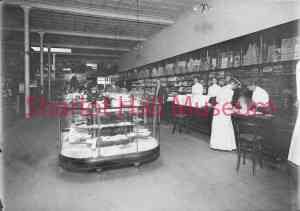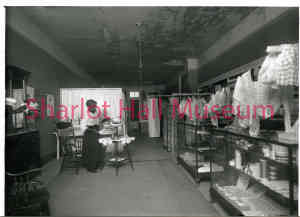By Marjory J. Sente
 When asked where she bought her hats, a 19th century Boston Blueblood is supposed to have said, “I don’t buy my hats. I have my hats.” The same could have been said for the ladies of Prescott during its early years. From department stores such as the Bashford-Burmister Company (B-B), Goldwater Brothers and the New York Store to sole proprietorships owned by women, including Miss Emma Ray, Mrs. Nellie B. Akers, Mrs. Mollie Evans and Madam Hunter Hilbert, millinery was big business in Prescott.
When asked where she bought her hats, a 19th century Boston Blueblood is supposed to have said, “I don’t buy my hats. I have my hats.” The same could have been said for the ladies of Prescott during its early years. From department stores such as the Bashford-Burmister Company (B-B), Goldwater Brothers and the New York Store to sole proprietorships owned by women, including Miss Emma Ray, Mrs. Nellie B. Akers, Mrs. Mollie Evans and Madam Hunter Hilbert, millinery was big business in Prescott.
Rebuilding after the great fire in 1900, B-B added a millinery department where ladies could buy ready-made clothing and hats. In 1904 Blumberg’s New York Store hired Miss Bottoms, an expert milliner from New York City, to head its millinery department. Besides the department stores, Prescott’s ladies also patronized the small women-owned-and-operated hat shops. At these shops they enjoyed the companionship of other women while purchasing hats especially curated for them or having an old hat retrimmed for the coming season.
 An early milliner, perhaps the first to open a shop in Prescott, was Miss Emma Ray. Ads for her millinery shop began appearing in the Arizona Weekly Miner in spring, 1875. Located next to Dr. McCandless on Gurley Street on the north side of the Plaza, she sold hats and other fine accessories, as well as dresses. Miss Ray was the only woman to appear in the July 9, 1874 Arizona Weekly Miner’s Business Directory. Shortly after opening her shop, Miss Ray became Mrs. Frank Smith and soon gave up her business. According to the 1880 U.S. Census, she had two children and was listed as keeping house.
An early milliner, perhaps the first to open a shop in Prescott, was Miss Emma Ray. Ads for her millinery shop began appearing in the Arizona Weekly Miner in spring, 1875. Located next to Dr. McCandless on Gurley Street on the north side of the Plaza, she sold hats and other fine accessories, as well as dresses. Miss Ray was the only woman to appear in the July 9, 1874 Arizona Weekly Miner’s Business Directory. Shortly after opening her shop, Miss Ray became Mrs. Frank Smith and soon gave up her business. According to the 1880 U.S. Census, she had two children and was listed as keeping house.
Mrs. Nellie B. Akers, the wife of J. W. Akers (Prescott’s postmaster from 1898-1902), started her millinery business in 1903. The March 18, 1903 Weekly Arizona Journal–Miner reported that Mrs. Akers had received two large showcases as well as a shipment of spring millinery, including pattern hats. Visiting her parlors was like a trip to fairyland. An experienced milliner, and lauded as one of the finest hat makers in Arizona, Mrs. Akers worked for the Edison Keith Company, a well-known millinery firm in Chicago, before moving to Prescott. Initially conducting business at 141 S. Cortez, she moved her millinery parlor to the former Stephens & Hoover Store on West Gurley Street by December 1903. The following April she became seriously ill with rheumatism and other complications and left for California for her health.
 A popular Prescott milliner during the early 1900s, Mrs. Mollie A. Evans owned the Crown Millinery located at 121 S. Cortez. In addition to her shop, she held trunk shows. She spent two days during September 1907 at the Grand Canyon Hotel in Williams and another two at Flagstaff’s Commercial Hotel selling the “large assortment of hats”. In November 1908, Mrs. Evans announced that she had sold her business to Mrs. J.A. Sprague of Denver. After going out of business, Evans turned the business over to Mrs. Sprague on December 1. Later that month, she married James H. Murein. As with many other milliners, marriage accounted for Mollie’s retirement from the business.
A popular Prescott milliner during the early 1900s, Mrs. Mollie A. Evans owned the Crown Millinery located at 121 S. Cortez. In addition to her shop, she held trunk shows. She spent two days during September 1907 at the Grand Canyon Hotel in Williams and another two at Flagstaff’s Commercial Hotel selling the “large assortment of hats”. In November 1908, Mrs. Evans announced that she had sold her business to Mrs. J.A. Sprague of Denver. After going out of business, Evans turned the business over to Mrs. Sprague on December 1. Later that month, she married James H. Murein. As with many other milliners, marriage accounted for Mollie’s retirement from the business.
The only known African-American milliner located in Prescott, Madam Jessica Hunter’s shop was at 134 North Cortez Street in 1916. Besides hats, trimmings and ribbons, she sold ready-to-wear dresses. After marrying Dr. E.E. Hilbert in 1919, Hunter’s business not only continued, but it expanded under the name Madam E.E. Hilbert.
To learn more about these female entrepreneurs and other milliners who conducted business during Prescott’s formative years, come to Marjory Sente’s talk on March 18, 2023 at 2 pm at the Sharlot Hall Museum in the Education Center Auditorium. Tickets are $15 or FREE for museum members. Seating is limited.
“Days Past” is a collaborative project of the Sharlot Hall Museum and the Prescott Corral of Westerners International (www.prescottcorral.org). This and other Days Past articles are also available at www.archives.sharlothallmuseum.org/articles/days-past-articles/1 The public is encouraged to submit proposed articles and inquiries to dayspast@sharlothallmuseum.org Please contact SHM Research Center reference desk at 928-277-2003, or via email at archivesrequest@sharlothallmuseum.org for information or assistance with photo requests.


